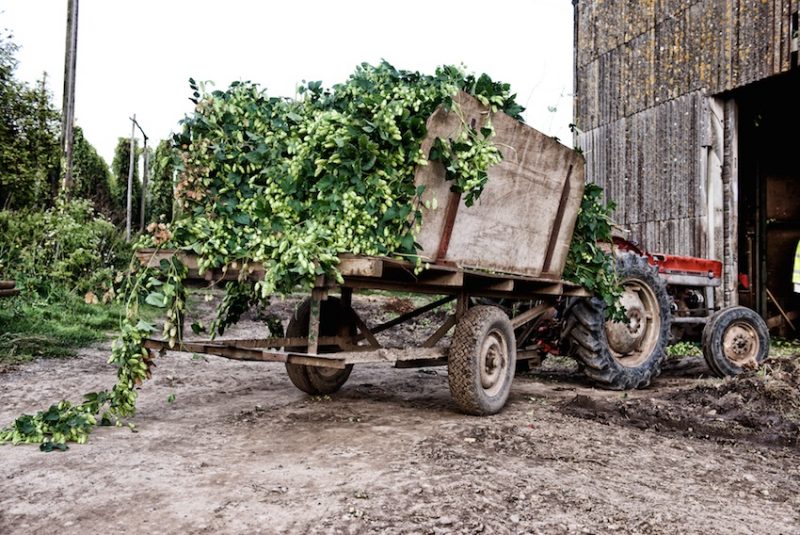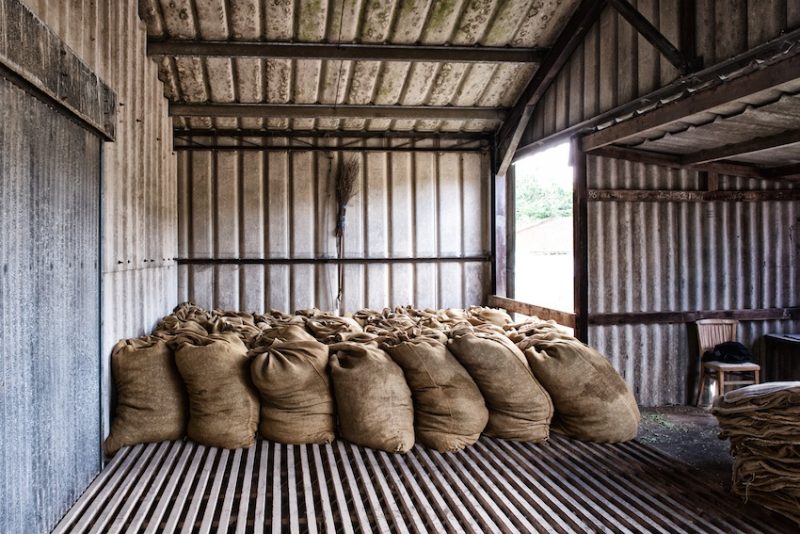‘It has been a wonderful year for hops, the weather has been perfect,’ says 23-year-old Anna Clinch of Syndale Farm near Faversham. The hop harvest started last week and will continue for another two weeks.
Anna, a graduate of Cirencester Agricultural College has run the hop pickers since she was 18 years old. ‘I love the team aspect of the harvest. There is a wonderful atmosphere.’

John and Anna Clinch of Syndale Farm, Syndale Valley
The Clinches have grown hops in Syndale Valley for very nearly a century. The combination of easy- draining brick clay soil and cold salt-laden winds off the North Sea are ideal for the crop. Hopping is clearly in the family’s blood. ‘After school I would run in, change, and go out to help pick,’ says Anna, who farms with her father John. They are descended from a long line of hop growers stretching back 300 years.
Once a ubiquitous sight all over Kent, hop gardens are now rare. A garden comprises row upon row of very tall chestnut poles supporting hops. Planted in the spring, the hops are trained up a system of strings on a wirework frame up to six metres high.

Perfect weather for growing hops
This is done by hand with a pole called a ‘monkey’. In the past the hops were strung and maintained by highly-skilled stilt-walkers.

Traditionally, hops were strung by stilt-walkers

Stringing the Hops by Felicity Warbrick. Acrylic on paper 160cm x 120cm
Hops were introduced to Kent around Maidstone from Flanders in the 15th century. Our national drink until then had been ale, unhopped and sometimes flavoured with herbs.
The Clinches are one of only seven growers in the South East, and with 22 acres, one of the smallest. There are 45 growers in Worcester, the other area renowned for its hops. Hop growing reached its peak in the 1880s when a staggering 77,000 acres were under cultivation but declined sharply due to a multitude of factors throughout the 20th century. One of the reasons is the popularity of lager which uses fewer hops than beer.

Hops in full flower ready to be harvested
Happily, the recent renaissance of craft beers has reinvigorated hop farming. Anna says: ‘When demand slackened we diversified to cherries and asparagus but we have now reverted to hops. People are tired of industrialised beers that all taste the same.’

The demand for hops is growing
The Clinches sell to America, China, several local micro-brewers and craft brewers including the Whitstable Brewery, Goachers and the Hopdaemon Brewery. ‘We have a fantastic relationship with all of them. They come to the harvest, often bringing a keg of beer for the pickers. It is very different from selling to the large brewers who we didn’t form a bond with.’
Traditionally, pickers from London’s East End arrived in droves in special hoppers’ trains.
In 1931, George Orwell and a friend masqueraded as tramps seeking employment as hop pickers. He drew on his experiences in A Clergyman’s Daughter (1935). Here are a few highlights from the diary he kept at the time:
‘The pickers seem to be of three types: East Enders, mostly costermongers, gypsies and itinerant agricultural labourers with a smattering of tramps.’
‘The most successful pickers are families……the woman in the bin next to us, a regular old-fashioned East Ender, kept her grandchildren at it like slaves – “Go on Rose, you lazy little cat, pick them ‘ops up. I’ll warm your arse if I get up to you”. The laws about child labour are disregarded utterly.’
‘As to the living accommodation, there is now a whole trip of Government officials to supervise it. But what can it have been like in the old days is hard to imagine, even now the average hop pickers hut is worse than a stable. My friend and I with two others slept in a tin hut ten feet across with two unglazed windows and half a dozen other apertures…. and no furniture save a heap of straw.’ Orwell concludes: ‘What keeps the business going is probably the fact that the Cockneys rather enjoy the trip to the country, in spite of the bad pay and in spite of the discomfort.’
To see evocative photographs of hopping as described by George Orwell, Spitalfields Life recently posted a wonderful blog of old photographs from an archive in Tower Hamlets: www.spitalfieldslife.com/2017/8/11/hopping/photography

A full load of just picked hop bines
These Dickensian practices were abandoned in the 1950s due the invention of an efficient machine called a Bruff which resembles a giant threshing machine.

Bines being unloaded ready for the Bruff

Hop pickers on quality control duty
Harvesting is executed by a tractor and a Crow’s Nest ladder on a trailer going up and down the rows cutting the hop stems, known as ‘bines’. The trailer is swapped for a new one every eight rows. ‘It is key to maintain the right pace and rhythm.’ The bines are fed into the Bruff which separates the leaves from the flowers.

The Bruff
The flowers are laid on a boarded floor and dried in a kiln on site. When cool they are scraped with a scuppet (what a delightful word), a shovel-like tool with a wooden square frame, into hessian sacks for delivery to the brewers.

Scuppets, traditional implements used in the harvesting of hops
‘Where we once employed 300 to hand pick, we now have 15 people’ says Anna, adding ‘We have had the same crew of local people for years. At one time we had travellers from Heathrow.’
The Clinches grow two hop varieties: Challenge, bred to cope with mechanisation and East Kent Goldings, traditional to East Kent. Used by Shepherd Neame in Spitfire, it is the first hop to be awarded Protected Designation of Origin status in 2013 and has a delicate floral aroma. Each hop has its own distinct complex aroma.
Traditionally, hop gardens are replanted every 20 years. The Clinches have one which is 50 years old and a particular favourite with one brewer.
I will never look at a dusty old hop bine in a pub with the same eyes having explored Syndale Farm during the harvest season.

Hops sacked up ready to be despatched to brewers
Text: Amicia. Photographs: Lisa
Hops & Harvest, a Boutique Festival, Kent Life Heritage Farm Park, Nr Maidstone ME14 3AU 9-10 September (www.kent-life.org.uk)